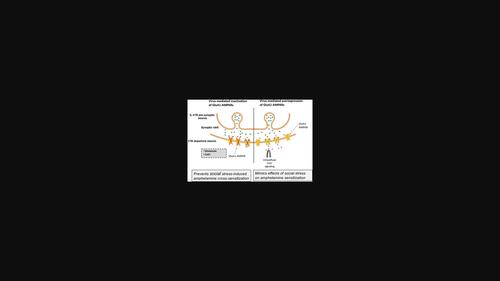当前位置:
X-MOL 学术
›
Eur. J. Neurosci.
›
论文详情
Our official English website, www.x-mol.net, welcomes your feedback! (Note: you will need to create a separate account there.)
Enhanced psychostimulant response, but not social avoidance, depends on GluA1 AMPA receptors in VTA dopamine neurons following intermittent social defeat stress in rats
European Journal of Neuroscience ( IF 3.698 ) Pub Date : 2020-06-28 , DOI: 10.1111/ejn.14884 Megan L. Rudolph 1, 2 , Racheal L. Neve 3 , Ronald P. Hammer 1, 2, 4, 5 , Ella M. Nikulina 1
European Journal of Neuroscience ( IF 3.698 ) Pub Date : 2020-06-28 , DOI: 10.1111/ejn.14884 Megan L. Rudolph 1, 2 , Racheal L. Neve 3 , Ronald P. Hammer 1, 2, 4, 5 , Ella M. Nikulina 1
Affiliation

|
Evidence from both human and animal studies demonstrates the importance of social stress in the development of addiction-related behaviour. In rats, intermittent social defeat stress causes long-lasting psychostimulant cross-sensitization. Our recent data reveal heightened expression of AMPA receptor (AMPAR) GluA1 subunit in rat ventral tegmental area (VTA), which occurs concurrently with social stress-induced amphetamine (AMPH) cross-sensitization. In addition, social stress in rats induced social avoidance behaviour. The present study evaluated the effects of intermittent social defeat stress on GluA1 expression in VTA dopamine (DA) neurons, then utilized Cre-dependent virus-mediated gene transfer to determine the functional role of homomeric GluA1-AMPARs in these neurons. Social defeat stress exposure induced GluA1 expression in VTA DA neurons, as demonstrated by a greater density of GluA1/tyrosine hydroxylase (TH) double-labelling in VTA neurons in stressed rats. Additionally, functional inactivation of VTA GluA1 AMPARs in DA neurons prevented stress-induced cross-sensitization, or augmented locomotor response to low dose AMPH challenge (1.0 mg/kg, i.p.), but had no effect on social stress-induced social avoidance behaviour. Furthermore, wild-type overexpression of GluA1 in VTA DA neurons had the opposite effect; locomotor-activating effects of AMPH were significantly augmented, even in the absence of stress. Taken together, these results suggest that stress-induced GluA1 expression in VTA DA neurons is necessary for psychostimulant cross-sensitization, but not for social avoidance. This differential effect suggests that different neural pathways are implicated in these behaviours. These findings could lead to novel pharmacotherapies to help prevent stress-induced susceptibility to substance abuse.
中文翻译:

增强的精神刺激反应,但不是社交回避,取决于大鼠间歇性社交失败压力后 VTA 多巴胺神经元中的 GluA1 AMPA 受体
来自人类和动物研究的证据表明,社会压力在成瘾相关行为发展中的重要性。在大鼠中,间歇性的社交失败压力会导致长期的精神兴奋剂交叉敏感。我们最近的数据揭示了 AMPA 受体 (AMPAR) GluA1 亚基在大鼠腹侧被盖区 (VTA) 中的表达升高,这与社会压力诱导的苯丙胺 (AMPH) 交叉致敏同时发生。此外,大鼠的社会压力会引起社会回避行为。本研究评估了间歇性社交失败压力对 VTA 多巴胺 (DA) 神经元中 GluA1 表达的影响,然后利用 Cre 依赖性病毒介导的基因转移来确定同源 GluA1-AMPAR 在这些神经元中的功能作用。社交失败压力暴露诱导 VTA DA 神经元中的 GluA1 表达,正如应激大鼠的 VTA 神经元中更高密度的 GluA1/酪氨酸羟化酶 (TH) 双标记所证明的那样。此外,DA 神经元中 VTA GluA1 AMPAR 的功能失活可防止应激诱导的交叉致敏,或增强对低剂量 AMPH 攻击(1.0 mg/kg,ip)的运动反应,但对社会应激诱导的社交回避行为没有影响。此外,VTA DA 神经元中 GluA1 的野生型过表达具有相反的效果。即使在没有压力的情况下,AMPH 的运动激活作用也显着增强。总之,这些结果表明,压力诱导的 VTA DA 神经元中的 GluA1 表达是精神兴奋剂交叉致敏所必需的,但不是社交回避所必需的。这种差异效应表明不同的神经通路与这些行为有关。
更新日期:2020-06-28
中文翻译:

增强的精神刺激反应,但不是社交回避,取决于大鼠间歇性社交失败压力后 VTA 多巴胺神经元中的 GluA1 AMPA 受体
来自人类和动物研究的证据表明,社会压力在成瘾相关行为发展中的重要性。在大鼠中,间歇性的社交失败压力会导致长期的精神兴奋剂交叉敏感。我们最近的数据揭示了 AMPA 受体 (AMPAR) GluA1 亚基在大鼠腹侧被盖区 (VTA) 中的表达升高,这与社会压力诱导的苯丙胺 (AMPH) 交叉致敏同时发生。此外,大鼠的社会压力会引起社会回避行为。本研究评估了间歇性社交失败压力对 VTA 多巴胺 (DA) 神经元中 GluA1 表达的影响,然后利用 Cre 依赖性病毒介导的基因转移来确定同源 GluA1-AMPAR 在这些神经元中的功能作用。社交失败压力暴露诱导 VTA DA 神经元中的 GluA1 表达,正如应激大鼠的 VTA 神经元中更高密度的 GluA1/酪氨酸羟化酶 (TH) 双标记所证明的那样。此外,DA 神经元中 VTA GluA1 AMPAR 的功能失活可防止应激诱导的交叉致敏,或增强对低剂量 AMPH 攻击(1.0 mg/kg,ip)的运动反应,但对社会应激诱导的社交回避行为没有影响。此外,VTA DA 神经元中 GluA1 的野生型过表达具有相反的效果。即使在没有压力的情况下,AMPH 的运动激活作用也显着增强。总之,这些结果表明,压力诱导的 VTA DA 神经元中的 GluA1 表达是精神兴奋剂交叉致敏所必需的,但不是社交回避所必需的。这种差异效应表明不同的神经通路与这些行为有关。



























 京公网安备 11010802027423号
京公网安备 11010802027423号